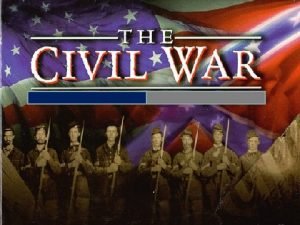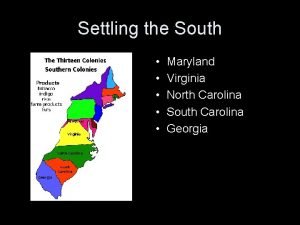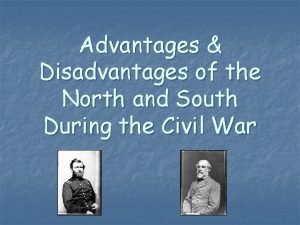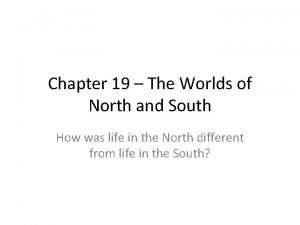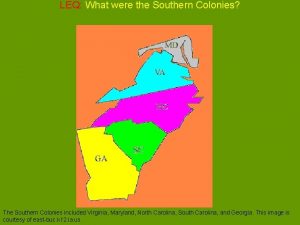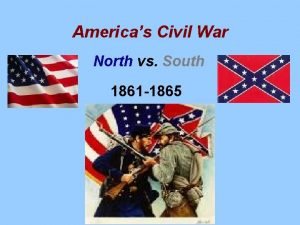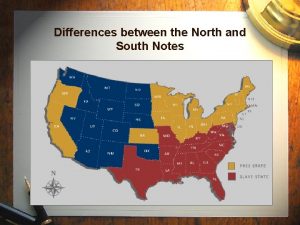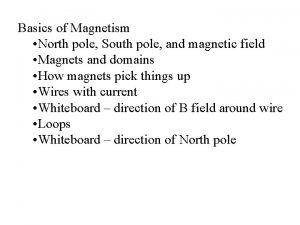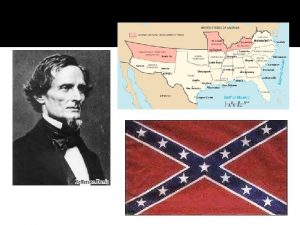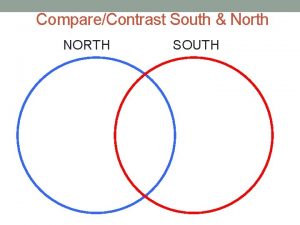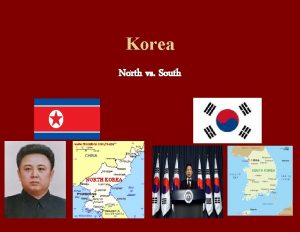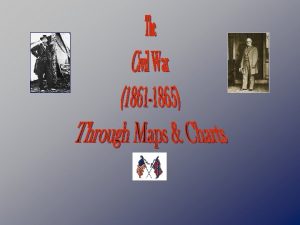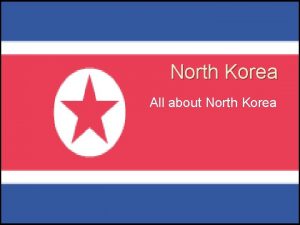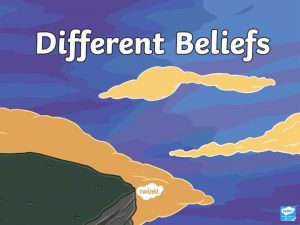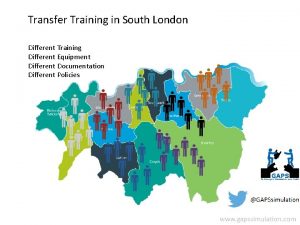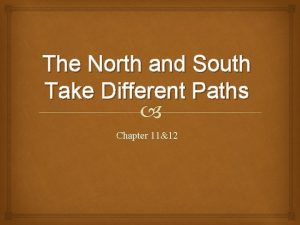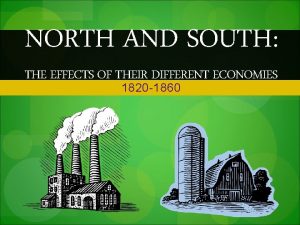North and South all that different North South
































- Slides: 32


North and South: all that different? North South ▪ Class Structure: generally based on wealth ▪ Class Structure: based on being “born” into it. ▪ Slavery: Abolitionists ▪ Slavery: supported ▪ Economy: factories and ship building. Politicians/military. Mining, banks, railroads ▪ North were ok with tariffs ▪ Economy: plantations (more land=more money) cotton, rice, tobacco, indigo ▪ Southerners resented tariffs, which raised import prices; the South imported more than the North

What invention caused Slavery to grow in the South? Cotton Gin! Who invented it? Eli Whitney

What is an abolitionist? Someone who is against slavery! Can you think of any?

William Lloyd Garrison “Wherever there is a human being, I see Godgiven rights inherent in that being, whatever may be the sex or complexion. ” i l o b A t s i n o ti

Frederick Douglass “What to the American slave is your Fourth of July? I answer a day that reveals to him more than all other day of the year, the gross injustice and cruelty to which he is the constant victim. To him your celebration is a sham; your boasted liberty an unholy license; your national greatness, swelling vanity; your sound of rejoicing are empty and heartless; your shouts of liberty and equality, hollow mock. . . ” https: //www. youtube. com/watch? v =wk. H 2 Ck-g. H 0 I i l o b A t s i n o ti

Harriet Beecher Stowe “It’s a matter of taking the side of the weak against the strong, something the best people have always done. ” i l o b A t s i n o ti

After the American Revolution, Georgia and the U. S. quickly expanded its territory. How did the issue of slavery affect new territory acquisition?

Every time the U. S. gained more territory, the gap widened between proponents and opponents of slavery. The South wanted slavery in new territories. The North wanted to contain slavery.

States Rights ▪ States’ rights: Belief that the state’s interests take precedence over interests of national government ▪ Northern states believed that all states should abide by laws made by the national government ▪ Southern states believed that states had right to govern themselves and decide what would be best for their own situation

Nullification ▪ Many Southern states believed that if the US Government created laws that took away their right to own slaves then those states had the right to nullify those laws. ▪ Nullification – Legal theory that states have a right to nullify, or invalidate, a law which that state viewed as unconstitutional.

The issues of slavery tied with the concept of states’ rights left a huge rift on the country. Controversy after controversy widened the gap, and for almost 40 years members of the U. S. Congress tried to close the wounds with compromises and acts that amounted to band-aids.

Missouri Compromise ▪ Compromise (agreement or settlement) between the northern and southern states; approved in 1820 ▪ Maine entered the Union as a free state, and Missouri entered as a slave state ▪ 11 states allowed slavery and 11 states did not ▪ Prohibited slavery north of 36° 20' latitude (the southern border of Missouri), and included Louisiana Territory lands west of Missouri ▪ Temporarily solved slavery controversy between the states

Compromise of 1850 ▪ Compromise between northern and southern states in 1850 ▪ California would enter Union as a free state ▪ New Mexico territory would not become part of Texas or a guaranteed slave state ▪ The District of Columbia would no longer trade slaves, but slave owners there could keep their slaves ▪ Runaway slaves could be returned to their owners in slave states ▪ Utah and New Mexico territories could decide if they wanted to allow slaves or not

Georgia Platform ▪ The Georgia Platform – Statement from the Georgia Convention in response to the Compromise of 1850. Supported by Union states, the Georgia Platform stated that the Southern states would agree to follow the Compromise of 1850 (and not leave the Union) as long as northern states would no longer attempt to take away rights from southern states.

Dred Scott Case ▪ Supreme Court ruling in 1857 ▪ A slave filed suit after he lived in free states with his owner but was returned to slave state ▪ Court ruled that slaves were not citizens and could not file lawsuits ▪ Court also ruled that Congress could not stop slavery in the territories ▪ Decision further separated the North and South

Slave Rebellions ▪ unsuccessful rebellions prompted strict laws across the South, known as Slave Codes, designed to curtail slave movements, meetings, and efforts to learn to read and write ▪ These laws applied to both slaves and freed blacks and gave slave owners nearabsolute power over their human property.

Election of 1860 ▪ Democratic Platform (Northern) – Stephen Douglas wanted people to decide about slavery in their own state/territory (popular sovereignty) ▪ Democratic Platform (Southern) – John Breckinridge wanted to ensure slaveholders could own slaves in new territories ▪ Republican Platform – Abraham Lincoln opposed the spread of slavery in new territories ▪ Constitutional Union Platform – John Bell wanted to keep the union intact Prediction activity: color the map, predicting which state voted for which candidate based on the info above

Election of 1860 ▪ In 1860, Abraham Lincoln, a Republican from Illinois, won election at President of the US. ▪ Northern states favored a Republican candidate that would help to abolish slavery. Southern states favored candidates that supported States’ Rights. • Northern States, California and Oregon supported Lincoln. • Most Southern states supported John C. Breckinridge • Most Border states supported either Stephen Douglas or John Bell

Post election Believing that Lincoln’s ultimate goal was to end slavery, the southern states voted one by one to secede from the Union. South Carolina was the first state to secede.

Debate over sucession in GA ▪ Georgians were, for the most part, for the Union; however, they were strongly for states’ rights ▪ Despite lawmakers’ strong debates for and against secession (leaving the union/country), a Secession convention began in January 1861 in Milledgeville, the capital ▪ A secession ordinance (bill) passed by a vote of 208 -89 ▪ The Southern states who seceded met in Montgomery, Alabama in February, 1861; they formed the Confederate States of America

Georgians in Leadership ▪ Alexander H. Stephens served as a Representative in Congress from Georgia from 1843 -1859. During this time he spoke against southern secession. However, after the southern states seceded from the Union Stephens was elected as Vice President of the Confederate States of America (CSA) in 1861. ▪ Robert Toombs was named Secretary of State of the Confederate States of American ▪ Governor Joseph E. Brown favored secession and used his terms as governor to prepare Georgia for war

Causes of the Civil War 1. Why were states’ rights an issue between the North and the South? A. The North wanted each state to form its own laws. B. The North did not want states to be able to make any of their own laws. C. The South wanted federal laws that applied to the whole country. D. The South did not want the federal laws to overrule the state laws.

Causes of the Civil War 2. Why did the Southern states want nullification? A. They wanted to be able to ignore federal laws that did not work in their favor. B. They wanted each state to be able to force Northern states to follow their laws. C. They wanted the laws of the Southern states to be applied to all of the Northern states. D. They wanted to separate from the Union without having to go to war.

Causes of the Civil War 3. Which action decided that California would enter the Union as a free state while any slave that escaped to the North must be returned to the South? A. Dred Scott case B. Compromise of 1850 C. Georgia Platform D. Tariff of 1828

Causes of the Civil War 4. What does the term “secession” describe? A. The end of slavery B. The act of a state leaving a nation C. The right of the federal government to collect taxes D. The nullification of tariffs

Causes of the Civil War 5. Look at the map to the right. Which conclusion could be drawn from the election results shown on this map? A. Georgia was a critical state in the election. B. The Southern states supported Lincoln’s policies. C. The nation was divided in its beliefs at this time. D. Lincoln had supporters in all regions of the country.

Causes of the Civil War 6. Read the quotation to the right. This statement would be said by someone that supports A. Election of 1860 B. Abolitionists C. State’s Rights D. Constitution “The National Government has no right to tell the states how to operate. ”

Causes of the Civil War 7. Why did the 1860 election of Abraham Lincoln prompt Georgia to hold convention about seceding from the Union? A. Lincoln wanted to repeal the Compromise of 1850. B. Lincoln supported the policy of popular sovereignty. C. Georgia felt threatened by Lincoln’s stand against slavery. D. Georgians feared that Lincoln would increase tariffs on British goods.

Causes of the Civil War 8. Based on this quote, what are the key issues and events that led to the Civil War? A. slavery and states' rights B. states' rights and nullification C. tariffs and domesticated goods D. domesticated goods and states' rights

Causes of the Civil War 9. Why did the U. S. Supreme Court rule against Dred Scott? A. He was property of his owner and could be taken anywhere. B. He did not live long enough in a free territory to be free. C. Scott was a slave and he was not allowed to sue in court because he was not a citizen. D. He returned to a slave state and he could not be freed.

Causes of the Civil War 10. The purpose of the Missouri Compromise was to A. Maintain a balance of slave and free states B. Let Missouri have slavery until 1850 C. Allow slavery in Maine but not in Missouri D. Return slaves captured in free states to slave states
 North and south lesson 1 the industrial north
North and south lesson 1 the industrial north Ngoại tâm thu thất chùm đôi
Ngoại tâm thu thất chùm đôi Block xoang nhĩ là gì
Block xoang nhĩ là gì Thể thơ truyền thống
Thể thơ truyền thống Thơ thất ngôn tứ tuyệt đường luật
Thơ thất ngôn tứ tuyệt đường luật Chiến lược kinh doanh quốc tế của walmart
Chiến lược kinh doanh quốc tế của walmart Tìm vết của đường thẳng
Tìm vết của đường thẳng Hãy nói thật ít để làm được nhiều
Hãy nói thật ít để làm được nhiều Tôn thất thuyết là ai
Tôn thất thuyết là ai Gây tê cơ vuông thắt lưng
Gây tê cơ vuông thắt lưng Sau thất bại ở hồ điển triệt
Sau thất bại ở hồ điển triệt Name three line segments
Name three line segments Advantages and disadvantages of the north and south
Advantages and disadvantages of the north and south Lines that run from north to south but measure is and west
Lines that run from north to south but measure is and west Maryland virginia north and south carolina and georgia
Maryland virginia north and south carolina and georgia North and south advantages and disadvantages
North and south advantages and disadvantages North and south strengths and weaknesses chart
North and south strengths and weaknesses chart Southwest asia and north africa map
Southwest asia and north africa map Angular distance latitude longitude
Angular distance latitude longitude Chapter 19 the worlds of north and south answer key
Chapter 19 the worlds of north and south answer key North and south states civil war
North and south states civil war Map of north carolina and south carolina
Map of north carolina and south carolina Us north vs south
Us north vs south Countries between south america and africa
Countries between south america and africa North and south notes
North and south notes North, central, and south america
North, central, and south america Define north pole and south pole
Define north pole and south pole Chapter 20 girding for war the north and the south
Chapter 20 girding for war the north and the south North east and north cumbria integrated care system
North east and north cumbria integrated care system Why do different polymers have different properties
Why do different polymers have different properties Why do different atoms produce different colors
Why do different atoms produce different colors Sound will travel at different speeds in different mediums.
Sound will travel at different speeds in different mediums. Sound will travel at different speeds in different mediums.
Sound will travel at different speeds in different mediums.












